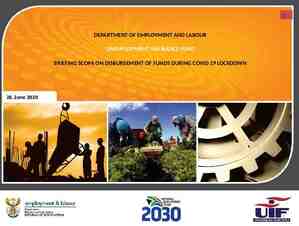Chapter 3 – Agile Software Development Pepper modification of
27 Slides2.32 MB

Chapter 3 – Agile Software Development Pepper modification of Sommerville presentation & Colm O’hEocha – AgileInnovation Ltd presentation Chapter 3 Agile software development 1

Topics covered Agile methods Plan-driven and agile development Extreme programming Agile project management Scaling agile methods Chapter 3 Agile software development 2

Rapid software development Why? Need to react to changes more quickly than 2 year long waterfall projects 2 years and then you got the design wrong anyway! Small deliveries aren't abstract How? Goal - Deliver working software quickly Compromise - less functionality in a delivery, not lower quality Less documentation Focus on the code rather than the design Interleave Specification, design and implementation are inter-leaved Deliver small versions and get user (stakeholder) input Chapter 3 Agile software development 3

es Copyright 2010 AgileInnovation Br it tle C od e Qu ali ty Re sp on siv en es s ity uctiv Prod ty plexi Com Tim Cycle Long Transparency Your Favorite! Painpoints

Agile manifesto Our values: Individuals and interactions over processes and tools Working software over comprehensive documentation Customer collaboration over contract negotiation Responding to change over following a plan That is, while there is value in the items on the right, we value the items on the left more. Chapter 3 Agile software development 5

Plan-driven and agile specification separate development stages with the outputs to be produced at each of these stages planned in advance. Iteration within stage Not necessarily waterfall model – plandriven, incremental development is possible User's full agreement at end, not before code Iteration of stage Chapter 3 Agile software development 6

Copyright 2010 AgileInnovation

Problems with agile methods It can be difficult to keep the interest of customers / users who are involved in the process. Team members may be unsuited to the intense involvement that characterizes agile methods. Prioritizing changes can be difficult where there are multiple stakeholders. Maintaining simplicity requires extra work. Contracts may be a problem as with other approaches to iterative development. Because of their focus on small, tightly-integrated teams, there are problems in scaling agile methods to large systems. Less emphasis on documentation - harder to maintain when you get a new team for maintenance Chapter 3 Agile software development 8

Balance plan driven and agile Not great for Agile: What type of system is being developed? Plan-driven approaches may be required for systems that require a lot of analysis before implementation (e.g. real-time system with complex timing requirements). What is the expected system lifetime? Long-lifetime systems may require more design documentation to communicate the original intentions of the system developers to the support team. What technologies are available to support system development? Agile methods rely on good tools to keep track of an evolving design How is the development team organized? Many teams; Outsourcing --- need design documents to control borders Culture or contract needs detailed specification Is rapid feedback from users realistic? Large scale, not co-located may require more formal communication methods Need high level programming skills - refactoring, work with little spec Outside regulation documentation requirements Chapter 3 Agile software development 9

Extreme programming A popular form of Agile Extreme Programming (XP) takes an ‘extreme’ approach to iterative development. New versions may be built several times per day; Increments are delivered to customers every 2 weeks; All tests must be run for every build and the build is only accepted if tests run successfully. Customer involvement means full-time customer engagement with the team. - Specifications through user stories broken into tasks People not process : pair programming, collective ownership and a process that avoids long working hours. Regular system releases. - release set of user stories Maintaining simplicity through constant refactoring of code. Chapter 3 Agile software development 10

The extreme programming release cycle Chapter 3 Agile software development 11

The Parts and the Whole Iteration Plan Daily Stand-Up Set Target Adapt Clean Design & Code & Refactor User Stories - Late Elaboration Shared Code Ownership Test Driven Development . Controller Inspect Sustainable pace Collective Ownership with users Minimal documentation for sprint Pair Programming Customer Reviews & Feedback Retrospectives AutoTest .

The Life of an Iteration Copyright 2010 AgileInnovation

Transparency “Tell me how you will measure me and I’ll tell you how I’ll behave” Copyright 2010 AgileInnovation

A ‘prescribing medication’ story Chapter 3 Agile software development 15

Examples of task cards for prescribing medication Chapter 3 Agile software development 16

Refactoring Programming team look for possible software improvements and make these improvements even where there is no immediate need for them. This improves the understandability of the software and so reduces the need for documentation. Changes are easier to make because the code is well-structured and clear. However, some changes requires architecture refactoring and this is much more expensive. RISK: Changes the user does not test Changes to working software break it Chapter 3 Agile software development 18

Examples of refactoring Re-organization of a class hierarchy to remove duplicate code. Tidying up and renaming attributes and methods to make them easier to understand. The replacement of inline code with calls to methods that have been included in a program library. Chapter 3 Agile software development 19

Test case description for dose checking Chapter 3 Agile software development 20

Test automation Automate tests (junit) Run upon checkin Difficulties: Time constraints Programmer preferences to not test Test coverage Chapter 3 Agile software development 21

Pair programming In XP, programmers work in pairs, sitting together to develop code. Common ownership Knowledge spread Informal review Refactoring Similar output to two people coding Chapter 3 Agile software development 22

Scrum Project Manager's job: - Deliver needed system on time within budget The Scrum approach - manage the iterations There are three phases in Scrum. outline planning phase - general picture and architecture Sprint cycles releasing increments of the system. The project closure phase - final delivery, documentation and review of lessons learned. Chapter 3 Agile software development 23

The Scrum process Chapter 3 Agile software development 24

The Sprint cycle Every 2–4 weeks (a fixed length). 1) Project team with customer: Look at product backlog select stories to implement 2) implement with all customer communication through scrum master (protecting pgmr at this point) Scrum master has project manager role during sprint Daily 15 min meetings Stand up often Team presents progress and impediments Scrum master tasked with removing impediments 3) Review system release with user Chapter 3 Agile software development 25

Scrum benefits The product is broken down into a set of manageable and understandable chunks. Unstable requirements do not hold up progress. The whole team have visibility of everything and consequently team communication is improved. Customers see on-time delivery of increments and gain feedback on how the product works. Trust between customers and developers is established and a positive culture is created in which everyone expects the project to succeed. Chapter 3 Agile software development 26

Summary Plan Driven (Ex: Waterfall) vs Incremental (Ex: Agile ) Structure and benefits and downfalls XP - an implementation of Agile - Power to the Programmer User story requirements Test driven design with continual retest and integration Pair Programming Refactoring encouraged Scrum - project management of Agile using sprints Iterations of full team contact / Scrum master protection of programmers / full team release review Chapter 3 Agile software development 27







